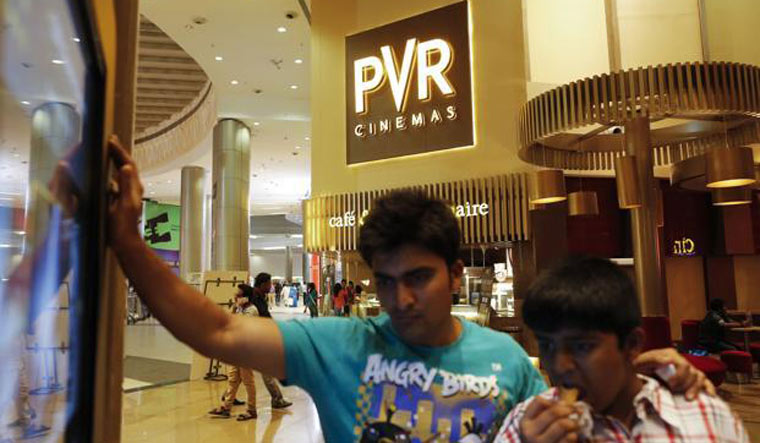The last two years have perhaps been the worst for India’s film exhibition industry. First, they were hit by COVID-19; the pandemic forcing them to down shutters for months, with restrictions, especially on capacity, in place until a few months ago. Secondly, they are now faced with huge competition from streaming platforms. Amid the pandemic and related lockdowns, consumers shifted to over the top (OTT) platforms like Netflix and Hotstar in a big way. In the face of this double whammy, the country’s top two multiplex operators, PVR and Inox, have agreed to merge.
This merger will need to pass through various regulatory hurdles, but once complete, Inox will merge with PVR and shareholders will get three shares of PVR for 10 shares of Inox. On Monday, Inox shares were up close to 13 per cent at Rs 529.75 and PVR traded four per cent higher at Rs 1,901.05.
The merged entity will be named as PVR Inox and the promoters of INOX will become co-promoters along with the existing promoters of PVR. Both the promoters will get two seats each on the newly constituted board. Cinema halls that will be opened post the merger will sport the new branding.
What is the strategic rationale behind the merger?
Inox operates 675 screens across 160 properties in 72 cities and PVR currently has 871 screens across 181 properties in 73 cities. The combined entity will become the largest film exhibition company in India operating 1,546 screens across 341 properties across 109 cities. But, there is a potential to reach over 200 towns and cities, say industry watchers.
Almost 70 per cent of the market is comprised of single-screen cinemas. However, many of them are struggling to recover from the huge hit the pandemic had on their earnings, forcing several of them to shut shop.
The multiplex industry, which has over 2,700 screens, too was hit hard. But, they were gaining share even before the pandemic and there is further headroom for growth, particularly in smaller towns, according to analysts.
“Given the large movie market [over 2,000], healthy box office collections, lower number of screens/cinemas, and a concentrated multiplex market [PVR/Inox command over 40 per cent market share], the multiplex market has healthy room to add new screens,” says Aliasgar Shakir, research analyst at Motilal Oswal Financial Services.
Back in 2013, PVR had acquired Mumbai-based Cinemax. Then, in 2015, it went on to buy DT Cinemas from DLF, and followed it by acquiring SPI Cinemas, which operated the famous Sathyam Cinemas in Chennai, in 2018, to broaden its reach in South India. Other than PVR and Inox, Cinepolis and Carnival are the only two major multiplex operators in the country.
The combined PVR-Inox will have 50 per cent share of the total multiplex screens in India at the end of March 2022, pointed Girish Pai, head of research at broking firm Nirmal Bang. He added that the share will only rise, with both PVR and Inox having more than 1,000 screens lined up to open over the next 5-10 years and this will give them a huge competitive advantage.
“We see this merger as significantly shareholder value accretive as it improves bargaining power vis-a-vis various stakeholders in the film exhibition ecosystem: advertisers, consumers, film producers, ticketing players etc,” said Pai.
The merger will provide higher pricing power in advertising, especially for Inox. PVR and Inox will also be in a position to raise rates further given they have some of the best locations in major urban centers, point analysts.
But, there are various risks ahead, a key being getting regulatory approvals. Even in the significantly smaller deal between PVR and DT Cinemas, some screens had to be divested for it to get a green light from the Competition Commission of India, pointed Pai.
If this rule is applied here, then both PVR and Inox may have to give up some screens in major metros like Mumbai and Delhi, he feels.
Furthermore, given that this industry has just few players, and the growth potential for India’s cinema industry is immense given rising aspirations of India’s middle class, many new players could yet be interested in entering the fray.
Kanakia Group, the past owner of Cinemax, has already announced its re-entry in the sector under a new entity Cineline, starting next financial year.
More importantly though, the threat from deep-pocketed OTT platforms looms large, something that even the management of the two companies has acknowledged.
Streaming platforms gained huge traction amid the pandemic. With the onset of OTT platforms, the time horizon between a movie’s theatrical release and subsequent availability on other platforms has come down significantly. If the trend continues and OTTs continue to see good traction, it will have an impact on occupancies at cinema halls and screen-level profitability metrics.
“OTT platforms pose a risk of shrinking the exclusive period, softening occupancies, and lower screen economics,” said Shakir of Motilal Oswal.
In totality, India’s cinema industry has close to 9,500 screens, while neighbouring China has close to 70,000. PVR and Inox will be hoping joining hands together will help them scale up more rapidly and cement their leadership position in this under penetrated, but growing, industry.





